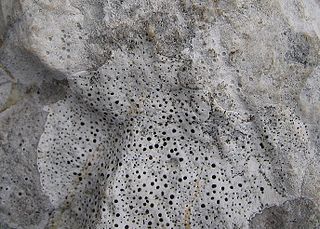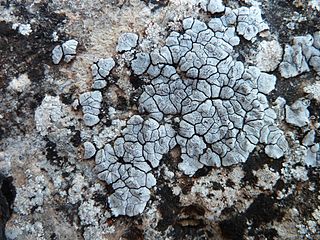
The Dactylosporaceae or Sclerococcaceae are a family of lichen-forming fungi in the class Eurotiomycetes. It is the only family of the order Sclerococcales and subclass Sclerococcomycetidae.

Verrucariales is an order of ascomycetous fungi within the subclass Chaetothyriomycetidae of the class Eurotiomycetes. Although most of the Verrucariales are lichenised, the family Sarcopyreniaceae consists of 11 species of lichenicolous (lichen-dwelling) fungi.
Bellemerella is a genus of fungi in the family Verrucariaceae. All four species are lichenicolous, meaning they grow parasitically on other lichens.
Norrlinia is a genus of two species of fungi in the family Verrucariaceae. The genus was circumscribed by Ferdinand Theissen and Hans Sydow in 1918. The genus name honours the Finnish botanist Johan Petter Norrlin. Both species are lichenicolous, meaning they parasitise lichens. The host of both fungi is the foliose genus Peltigera.
Merismatium is a genus of lichenicolous (lichen-dwelling) fungi of uncertain familial placement in the order Verrucariales. The genus was circumscribed in 1898 by Friedrich Wilhelm Zopf.
Telogalla is a genus of lichenicolous fungi in the family Verrucariaceae. It has two species. The genus was circumscribed by Nikolaus Hoffmann and Josef Hafellner.
Sarcopyrenia is a genus of lichenicolous (lichen-dwelling) fungi. It has 11 species. It is the only genus in Sarcopyreniaceae, a family in the order Verrucariales. Sarcopyrenia was circumscribed by Finnish lichenologist William Nylander in 1858, with Sarcopyrenia gibba assigned as the type species. Sarcopyreniaceae is one of the few families composed entirely of lichenicolous fungi.
Gyrophthorus is a genus of lichenicolous (lichen-dwelling) fungi in the phylum Ascomycota. The relationship of this taxon to other taxa within the phylum is unknown, and it has not yet been placed with certainty into any class, order, or family. The genus was circumscribed in 1990 by Josef Hafellner and Leopoldo Sancho, with Gyrophthorus perforans assigned as the type species.
Rhymbocarpus is a genus of lichenicolous (lichen-dwelling) fungi in the family Cordieritidaceae. It has 10 species. The genus was circumscribed by German mycologist Friedrich Wilhelm Zopf in 1896, with Rhymbocarpus punctiformis assigned as the type species.

Nesolechia is a genus of parasitic fungi in the family Parmeliaceae. All three species in the genus grow on lichens. Nesolechia probably evolved from a lichen ancestor, as it is closely related to many lichenized species of fungi.
Briancoppinsia is a fungal genus in the family Arthoniaceae. It is monotypic, containing the single species Briancoppinsia cytospora, a lichenicolous fungus that parasitises parmelioid lichens, as well as Cladonia, Lepra, and Lecanora conizaeoides, among others. The species was first described scientifically by Léon Vouaux in 1914 as Phyllosticta cytospora. The genus was circumscribed in 2012 by Paul Diederich, Damien Ertz, James Lawrey, and Pieter van den Boom. The genus was named for Brian John Coppins, who is, according to the authors, an "eminent British lichenologist and expert of lichenicolous fungi".
Lichenosticta is a genus of fungi of uncertain familial placement in the order Lecanorales. It has five species. All species are lichenicolous, meaning they are parasitic on lichens.

Leprocaulaceae is a family of mostly lichen-forming fungi. It is the single family in the monotypic order Leprocaulales. Leprocaulaceae contains three genera and about 33 species.
Xenonectriella subimperspicua is a species of lichenicolous fungus in the family Nectriaceae. It has been recorded from South America, Europe, and New Zealand.

Placocarpus schaereri is a species of saxicolous (rock-dwelling), areolate, and crustose lichen in the family Verrucariaceae. Found in Europe, it is the type species of genus Placocarpus. The lichen was first described scientifically in 1831 by Elias Magnus Fries, who called it Parmelia schaereri. The species epithet honours Swiss pastor and lichenologist Ludwig Schaerer. Othmar Breuss transferred it to the newly reinstated genus Placocarpus in 1985.
Phacopsis thallicola is a species of lichenicolous (lichen-dwelling) fungus in the family Parmeliaceae. It was first formally described as a new species in 1852 by Italian botanist Abramo Bartolommeo Massalongo, as Lecidea thallicola. The type specimen, collected from the province of Treviso in Italy, was growing on the foliose lichen Parmelia caperata. Dagmar Triebel and Gerhard Walter Rambold transferred the taxon to the genus Phacopsis in 1988. The known generic hosts of Phacopsis thallicola are all in the Parmeliaceae: Parmotrema, Cetrelia, Flavopunctelia, and Hypotrachyna.
Crittendenia is a genus of lichenicolous (lichen-dwelling) fungi in the monogeneric family Crittendeniaceae. The genus was circumscribed in 2021 to contain two species, C. lichenicola, and the type, C. coppinsii. An additional 16 species were added to the genus the following year. The genus name honours British lichenologist Peter Crittenden.
Rhagadostoma is a genus of fungi in the family Nitschkiaceae. All species in the genus are lichenicolous, meaning they live parasitically on lichens.

Abrothallus welwitschii is a species of lichenicolous fungus in the family Abrothallaceae. It grows on species of the foliose lichen genus Sticta. The type specimen was originally collected in Portugal in 1840 by Austrian botanist Friedrich Welwitsch, and it is after him for whom the species is named. Camille Montagne described the species in 1851, but he did not published the name validly; it was published validly by Charles Tulasne a year later.
Endococcus thelommatis is a species of lichenicolous (lichen-dwelling) fungus in the family Lichenotheliaceae. It was formally described as a new species in 2011 by lichenologists Jana Kocourková and Kerry Knudsen. The fungus grows on the lichen Thelomma santessonii, a common saxicolous (rock-dwelling), crustose lichen that is endemic to the coast and islands of Southern California and Mexico's Baja California. Endococcus thelommatis is the first lichenicolous fungus to have been reported from this lichen.






